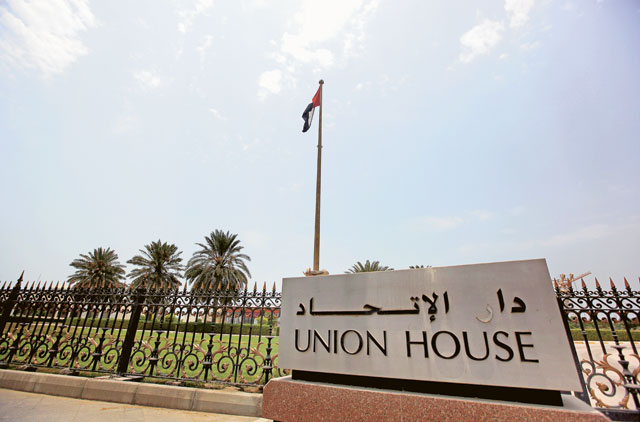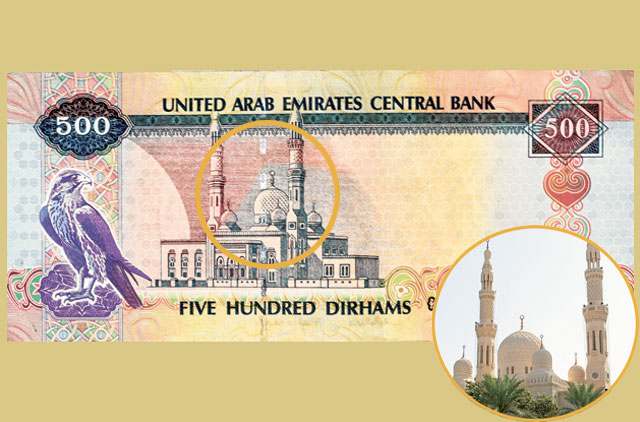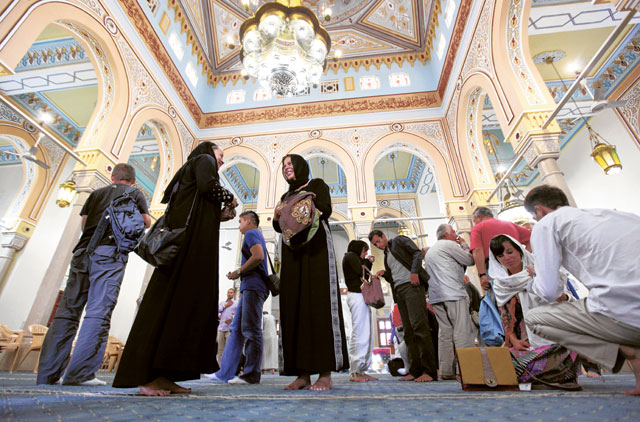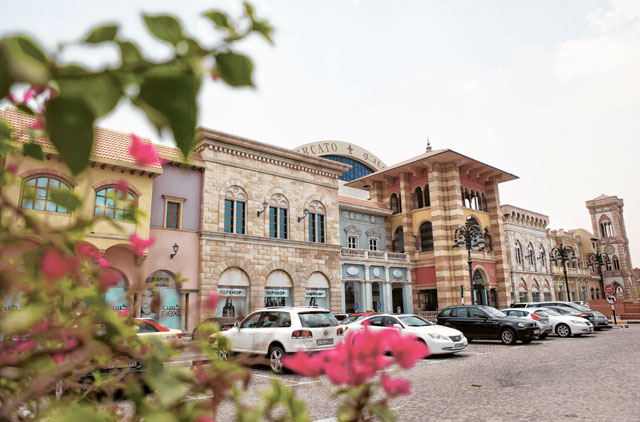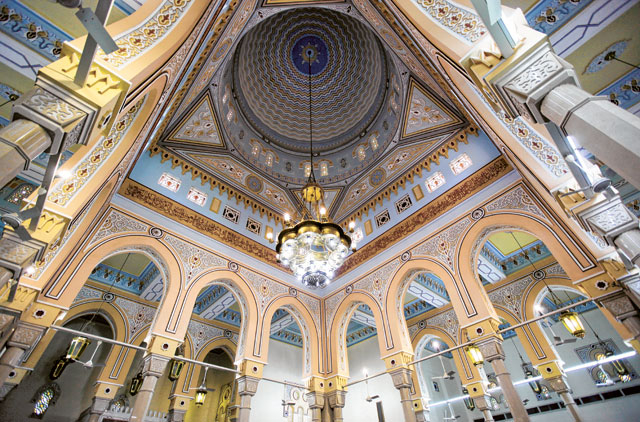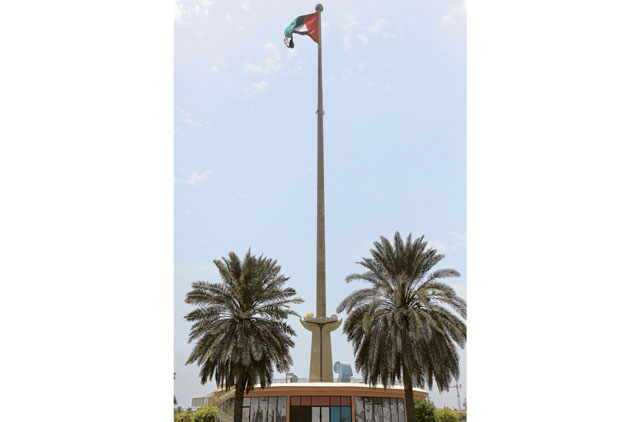
Dubai: Long before the cluster of restaurants, cosmetic surgery centres and fashion boutiques sprung up along Jumeirah Beach Road, the area used to be a serene residential neighbourhood whose crowd-pulling monuments in the 1980s consisted of the Chicago Beach Hotel and Jumeirah Grand Mosque.
Although the Chicago Beach Hotel was demolished and renamed Jumeirah Beach Hotel in 1997, Jumeirah Mosque is one of the few remaining infrastructures that have been meticulously maintained since its launch in 1975.
Also known as ‘the two minaret mosque,' it is featured on the Dh500 note and was built under the patronage of Shaikh Rashid Bin Saeed Al Maktoum. Jumeirah Mosque stands apart from the rest of the mosques in the neighbourhood due to its distinctive architecture that is based on the Fatimid style, and can accommodate up to 1,300 people.
It is only one of three mosques in the UAE open to non-Muslims — the others being the recently opened Al Farooq Omar Bin Al Khattab Mosque in Al Safa, Dubai, and Shaikh Zayed Grand Mosque in Abu Dhabi.
Over the past ten years, the Shaikh Mohammad Centre for Cultural Understanding has been organising visits to Jumeirah Mosque for non-Muslims, aimed at promoting cultural understanding and first-hand experience as an insight to the Islamic religion.
Tours
Mosque tours are offered four times a week and take around 75 minutes, they provide visitors with the opportunity to learn about the five pillars of Islam, how Muslims pray and the purpose of wearing abayas.
The mosque offers a cool haven for visitors away from the scorching sun and honking cars, and its plush green carpet also offers an atmosphere of calmness that allows the mind to peacefully delve into thought and acts of devotion.
As in the case with many mosques, the prayer hall was constructed in the hypostyle form, where the roof is held up by a multitude of columns. Opposite the entrance to the prayer hall is the qiblah wall. The wall is where worshippers pray in rows, facing the direction of the Ka'aba.
At the centre of the qiblah lies the mihrab, which serves as the location where the imam leads the five daily prayers on a regular basis.
Jumeirah 1, where the mosque is situated, is a place frequently visited by residents as opposite lies Palm Strip Mall — a small open-area shopping centre with a variety of shops that offer everything from clothes to ice cream parlours and restaurants.
"I live at Jumeirah Beach Residence, which is a bit far from here, but I enjoy the change [in scenery] because this neighbourhood is filled with families and different styles of villas. It's also more quiet here than where I stay, and I visit the area at least once a week for my Pilates class and when I fancy food from the Lime Tree Cafe," Briton Sam Little, said.
"I've been in Dubai for a year and never saw the beach until now. I used to work at the other side of the city, but now that I switched branches and started to work in Jumeirah, I get to see the beach every day. It's amazing because I can see the nature, and can start planning on having day trips at the beach with my friends," Sandee Gray, a Filipina saleswoman explained.
"I've been living in this area for almost 25 years and it is truly the best place to be in the city. On Fridays, I like to go swimming at the beach with my friends and have a barbecue. Even though I am not a Muslim, I made it a point to visit Jumeirah Mosque because I have heard so many nice things about it, and what they say is true. It is really an impressive mosque to see," Jyanda Kumar, and Indian resident, said.
A replica
One of the other famous landmarks in the area that visitors cannot afford to miss is that of Union House, which used to be home to the office of the former ruler Shaikh Rashid Bin Saeed Al Maktoum.
Over the years, a replica of the ‘Roundhouse‘ has been constructed to honour the site where documents were signed in 1972 for the formation of the UAE, uniting the emirates of Abu Dhabi, Dubai, Sharjah, Fujairah, Umm Al Quwain and Ajman. Ras Al Khaimah joined later.
In 1968 Shaikh Zayed Bin Sultan Al Nahyan and Shaikh Rashid Bin Saeed Al Maktoum decided to form an independent union between Abu Dhabi and Dubai and invited the other five states as well as Qatar and Bahrain to join them. Although Bahrain and Qatar chose to proceed to separate independence, Sharjah, Ajman, Umm Al Quwain and Fujairah agreed to join the union.
On the afternoon of Thursday, December 2, 1971, Shaikh Zayed, Shaikh Rashid, Shaikh Khalid Bin Mohammad Al Qasimi, the then Ruler of Sharjah, Shaikh Rashid Bin Humaid Al Nuaimi, the then Ruler of Ajman, Shaikh Mohammad Bin Hamad Al Sharqi, the then Ruler of Fujairah, and Shaikh Rashid Bin Ahmad Al Mualla, the then Crown Prince of Umm Al Quwain, met in this circular building to sign the declaration forming the union of the Arab emirates and elected Shaikh Zayed president of the newly formed nation.
Ras Al Khaimah joined in February 1972.
Towering over the surrounding land, the towering 120-metre flagpole flies over Union House, one of the most historically important sites in the UAE. It marks the place on which the rulers of the seven emirates united to form the federation of the United Arab Emirates on 2 December, 1971. In addition to signing the federation, Union House is also the site where the UAE flag was first unveiled and raised for the first time to a 21-gun salute; although the gold flagpole was not constructed until 2001.
There is a piece of history in the money that you carry. UAE currency notes portray landmarks in the country. In this report we feature Jumeirah Mosque pictured on the Dh500 note


